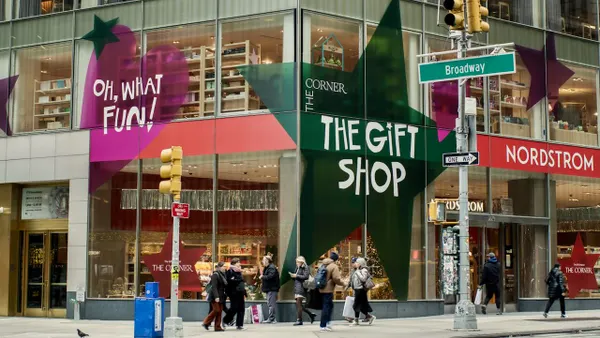Dive Brief:
-
Hurricane Irma in Florida (like Harvey in Texas before it), is buffeting area retailers. Those selling critical items like food, water and home improvement items are better positioned than those selling discretionary fashion and other merchandise without "deep-value," according to a note from Cowen & Co. emailed to Retail Dive.
-
The investment bank also noted "medium-term concerns" on hurricane-related disruptions of supply chains in all categories. That could mean delays in holiday goods and inventories, Cowen analysts warned. Marketplace sellers in Florida appealed to Amazon to allow shipments of holiday merchandise ahead of the storm in August, according to the Amazon seller forum.
-
Some $2.75 billion in consumer and retail sales (including restaurants) could be lost to Irma, in addition to costs incurred by the damage caused directly by the storm, according to Planalytics, which provides weather-related planning tools for businesses. Early storm Hurricane Harvey cost businesses some $1 billion in that measure, Planalytics said in an email to Retail Dive.
Dive Insight:
The focus in the preparation, midst and aftermath of any hurricane, especially the high-category forces from the likes of Irma and Harvey, is on the protection of human life. Many retailers have a part in that, providing key staples like food and water and products to shore up homes, as well as in ensuring that their employees are kept safe.
Retailers selling critical supplies tend to benefit from such storms, while businesses like restaurants and apparel retailers have almost no business. But it’s all mostly temporary.
"What almost always happens when you get a big event like this is you really see three phases from a retailer perspective," Paul Walsh, VP of weather strategy and business meteorologist at The Weather Company, told Retail Dive last year. "Actually, it’s really from a consumer perspective, and the retailers’ job is to be ready for their customers’ needs."
Those phases are the forecast (when people tend to stock up), the storm itself (when retailers need to decide how long to stay open — to help people who need supplies without endangering workers), and the aftermath, (when people return to stores to stock up on things they’ve run out of, and take up shopping again for things they don’t immediately need).
More than six million people were forced to evacuate the state of Florida, the most on record, and more voluntarily left the state, according to Planalytics. Cowen analyzed 19% of stores located in the Southeast region and based on their rankings, Walmart, Costco and Target stood to benefit on balance, partly offset by store closures forced by the storm. But Cowen analysts noted that post-storm inventory-taking and damage assessment shouldn’t be the only consideration, and warned that some retailers may not fully recover.
"We are hopeful that retailers have been using weather forecasting to pre-position inventory needs and accelerate inventory flow in distribution centers," Cowen analysts said. "We believe spending in discretionary categories such as apparel and accessories could be unlikely to substantially rebound and store closures will yield lost sales ([including apparel retailers] and department stores). [M]eanwhile, needs to rebuild homes and home improvement will likely benefit from recovery efforts."
Indeed, while storms like Irma and Harvey are particularly devastating to life and property, most storms are less violent and more predictable, and retailers should lean on what Walsh calls the "weather excuse" for lost sales less and less, as they benefit from — and get better at leveraging — both long and short-term weather forecasting data, as well as the information about their customers’ weather-influenced behavior.
This story is part of our ongoing coverage of the 2017 holiday shopping season. You can browse our holiday page and sign up for our holiday newsletter for more stories.














